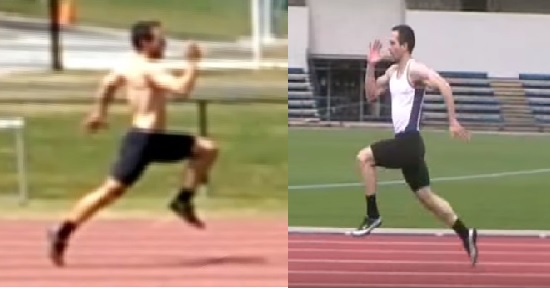You’re welcome BEGR8. The issue with the slang is definitely a problem across all sports. I’ve consulted for years across a variety of disciplines and each one has their own assortment of jargon.
Looks like slightly different points in the stride phase, though. it’s hard to know for sure, but it looks like the shot on the left is at the point of extension and lift off from the track, while on the right you have already started to recover the leg. this means that the other leg has probably already started heading downwards, whereas in the first pic it is right at its peak height…
You’re right. Here is a better comparison:  The analysis still holds though. Back then I had a more neutral pelvis, less knee extension at toe off and a shorter ground contact.
The analysis still holds though. Back then I had a more neutral pelvis, less knee extension at toe off and a shorter ground contact.
So basically, if I understand correctly, “sitting back” is a misleading cue that can fix pelvic position at the expense of hip height, right? and it’s best to cue proper pelvic position in drills first, then progressing to tempos, then sprints, with proper feedback and cues to make sure the athlete is not sacrificing hip height and stepping down properly while practicing proper pelvic position.
Also agree that terminologies people use are often different and can be confusing.
Thank you.
In general yes. It’s not, however, that slang cues are necessarily a bad thing; particularly if they resonate with an athlete and get the job done. The issue is that it’s more sensible to start things off with the proper vocabulary in order that all parties involved are communicating intelligibly, and will continue to be understood regardless of how broad the network becomes.
isn’t this one of those things that is best fixed with conditioning? if you’re too tight in your glutes/hams or hipflexors/quads, or too weak, then you won’t be able to properly achieve or maintain those positions, regardless of what cues you are given…
Additionally, abdominal strength needs to be superb.
I would think that it’s something that requires strength and muscular balance (as you said, glute ham, hip flexor, quad, etc.) to be able to execute. Only then, the athlete will be able to properly execute the given cue. I think that it would likely require technical practice, and won’t just occur automatically even if you have the right strength and balance requirements.
Hornblower/Rainy.Here, remember that ‘form follows function’. In this way, while it is true that the associated skeletal muscle integrity is one of the substrates for achieving both kinematic position and kinetic motion, it’s important not to forget that the essential factor is ‘how’ that quality is developed (this is what you are referencing Kwave).
The holistic interplay between all intelligibly selected preparatory elements is key and as far as movement is concerned- it leads the charge.
Don’t forget that drills and sprints are the most specific forms of strength training for a sprinter.
James Smith, thank you for sharing your knowledge on the forum. I really enjoy reading your posts.
My pleasure KK400
Thanks. Reminds me I need to try to monitor my athletes better during warm-up (I have a large section of new athletes right now) for drill technique.
PS - About 11 years ago when I first registered (I know my account says 2007), I had to re-read your posts, and sections of them, multiple times to understand fully what you were getting at. I’m not down to about two readings. 
Sure thing. Down to two readings…shame on me. Seems as if I’m not sufficiently overcomplicating things (wink).